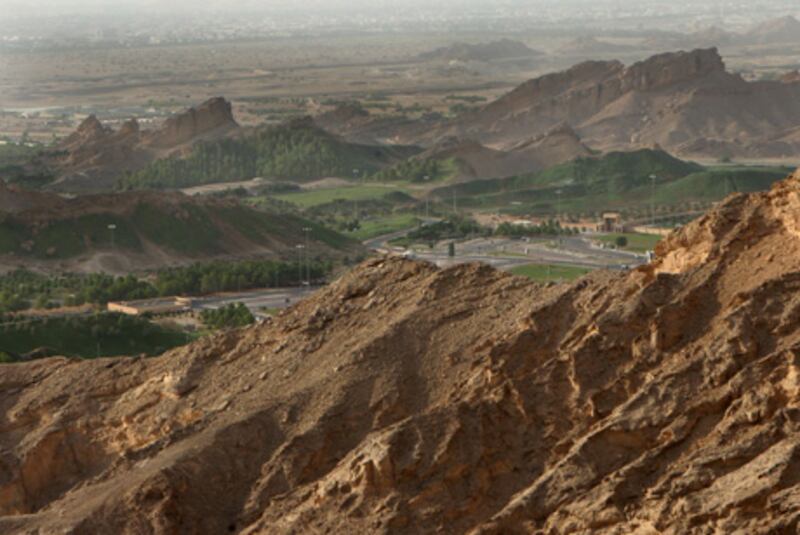ABU DHABI // Al Ain joined a prestigious list today that includes Egypt’s pyramids and India’s Taj Mahal when it was named a Unesco world heritage site.
The dome-shaped tombs of Hafeet, the man-made water system of falaj and the lush oases sought out for thousands of years by travellers were given the international seal of approval in Paris after years of work.
Report: The Cultural Sites of Al Ain
Read the World Heritage Site Nomination Summary by Abu Dhabi Culture & Heritage
Click here for the full report
Al Ain is the first site in the UAE to make the heritage list and the decision comes after repeated inspections of the sites and eight years of preparation from the Emirati side.
“Al Ain constitutes a serial property that testifies to sedentary human occupation of a desert region since the Neolithic period with vestiges of many prehistoric cultures,” said Unesco.
The international body emphasised the importance of Hili as it features “one of the oldest examples” of the falaj irrigation system dating to the Iron Age. “The property provides important testimony to the transition of cultures in the region from hunting and gathering to sedentarization,” Unesco said.
Al Ain was one of 37 sites submitted by 40 countries, and was the third Arab country to win a place this year alongside Jordan’s Wadi Rum and Syria’s ancient northern villages.
Classified as a “cultural site”, the winning locations in Al Ain include its six oases and the archaeological sites of Bida bint Saud, Hafeet and Hili. The Al Ain file was submitted in 2008 by the Abu Dhabi Authority for Culture and Heritage (Adach) in cooperation with the National Council for Tourism and Antiquities. Work on the file began in 2003.
“This is a great honour and is proper recognition of the historical sites in the emirate of Abu Dhabi,” said Sheikh Sultan Bin Tahnoon Al Nahyan, the chairman of Adach. “This work is further testament to the richness and commitment that Adach has in working to protect and promote Abu Dhabi.”
Dr Sami El Masri, Adach’s deputy director general for arts, culture and heritage, said that Unesco’s recogntion of Al Ain was a testimony “of an important culture and identity that has left its mark on the history of world civilization and human contacts in the past and present day”.
Al Ain city’s six oases sustained its development as far back as 2000BC, and each of its archaeological sites tells a crucial part of the story.
“Al Ain is one of the most beautiful cities in the region,” said Dr Hasan Al Naboodah, an Emirati historian and the dean of libraries at the UAE University in Al Ain. “For thousands of years, Al Ain has been the refuge site sought out by travellers from across the area, heading along the east/west caravan route or the south and north route of Arabia. The archaeological sites, and the artefacts found at these sites, compliment the long natural history of Al Ain as an important oasis.”
Some of the finds, such as Mesopotamian pottery fragments inside Hafeet tombs, helped to substantiate trade links between Mesopotamia and the UAE as far back as 3000 BC.
Gina Doubleday, from the Promotion, Publications and Education Unesco World Heritage Centre, explained the significance of this win.
“It draws attention to the value of the site and Unesco provides support in the form of expertise and networking with similar sites around the world,” she said. “The site is also regularly monitored by the UN body and protected from being damaged by development or other threats.”
The winning sites define critical periods in the Bronze Age of south-east Arabia, which lasted from 3200 to 1300BC. The Hafeet tombs, the earliest tombs of the Bronze Age in the UAE, gave their name to a period known as “the Hafeet period”, which dates from 3200BC to 2700BC. About 500 of these 5,000-year-old dome-shaped tombs lay at the bottom of Jebel Hafeet mountain.
The Iron Age saw the birth of the falaj system, an underground water supply that allowed water to be transported from the mountains to the plains. The system, which exists to this day, led to the construction of permanent settlements and agriculture in Al Ain. These 1000BC falaj were shared by the inhabitants up until the early 20th century before they needed updating.
As a member on Unesco’s jury for the proclamation of masterpieces of oral and intangible heritage of humanity between 2001 and 2005, Dr Al Naboodah recalled how attempts to enter the UAE falconry file into the list of intangible heritage was refused several times on the grounds it was related to hunting.
“When it was presented as a sport and hobby, then it had a better chance,” said Dr Al Naboodah.
It took four years of campaigning by UAE and 11 other countries to get falconry recognised by Unesco last year as an example of intangible cultural heritage.
The International Union for Conservation of Nature only last week called on Arab nations to propose more natural sites. In a report, it said that the Middle East has the fewest natural world heritage sites.
“The Arab states are home to an exceptional natural wealth and diversity, with striking desert landscapes and marine areas,” said Haifa Abdulhalim, the union’s heritage officer in the Arab states.
The Middle East has nominated two areas for special protection in 15 years. Four are listed: Banc d'Arguin National Park in Mauritania, Ichkeul National Park in Tunisia, the Socotra Archipelago in Yemen and the Wadi Al Hitan in Egypt. Jordan's Wadi Rum joins the list this year.
rghazal@thenational.ae






